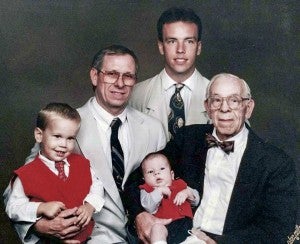I’m getting old
Published 8:59 am Friday, July 17, 2015
I was only a freshman in college when I spotted my first gray hair. It wasn’t all that noticeable because my hair was a lot shorter than it is now, but there it was. Standing in front of the mirror in my dorm room, I debated whether or not I should pluck it and forget about it or if three more would grow back in its place.
Now 25 years old, I’ve accepted the fact that I’m graying. It’s no longer just one hair, either. Brushing my mane, what seems to be hundreds of silver strands shine brightly in the lights of my vanity as if they’re taunting me.
“You’re getting old, Andrew,” they say.

Because gray hair is a genetic predisposition, I have this natural progression to look forward to. From left, myself, my grandfather Ronald, my brother Aaron, my father Jeffrey and my great-grandfather Jacob. — SUBMITTED | ANDREW LIND
I look at my father, who has had salt and pepper on top of his head for as long as I can remember. I used to poke fun at him, saying I’d buy him hair care products for his birthday, but I’m now wishing that I didn’t because it was only a sign of things to come.
Yep, genetics are a strong indicator of when our hair turns gray, and to explain, we must get to the root of the problem … I mean, the root of our hair.
Under our scalp is a tiny sac from which hair grows called the follicle. Each follicle contains a number of cells that produce pigment called melanin, which that gives hair, eyes and skin its color. When the follicle stops producing this pigment, that strand of hair will become transparent and look gray, white or silver.
As we get older, the number of pigment cells that produce melanin become depleted. Not only does our hair lose its color, but the lack of moisture-providing melanin turns it brittle.
There are a number of things that can contribute to early graying, like smoking, which decreases melanin production; Werner’s syndrome, a condition associated with premature aging and an increased risk of cancer; and pernicious anemia, a disease in red blood cells that results in a vitamin B-12 deficiency.
But doctors and researchers alike say that gender and genetics are the usual culprits. The average male starts to gray around age 30, while it is slightly later at the age of 35 for women. It may happen sooner for some and later for others, but typically, we only have to look at our parents and grandparents to determine when it will happen to us. It’s funny that parents typically blame the stress from their kids for their graying hair when they should really be looking the other direction on the family tree.
“It’s kind of a straightforward answer because there is a genetic predisposition to gray hair, when it will happen and whether it is gray, silver or white,” dermatologist Dr. Thomas Garrott told the Seattle Times. “I explain our appearance this way: Because of our genetics, there is a picture of you when you are 100 years old and you just work your way there.”
I’ve looked at my premature graying from various points of view. At first I panicked, but then I came to terms. I’ve been told it looks distinguished, sexy, suave, rugged, mature and sophisticated, and that gives me a boost of confidence. I wish I would have looked at it that way sooner, especially considering that there will come a time in the not too distant future that I won’t have any pepper sprinkled among the salt.
With these years of experience, I guess I’ll prepared for the day that I’ll be called a silver fox.
Andrew Lind is a staff writer at The Tidewater News. He can be reached at 562-3187 or andrew.lind@tidewaternews.com.

